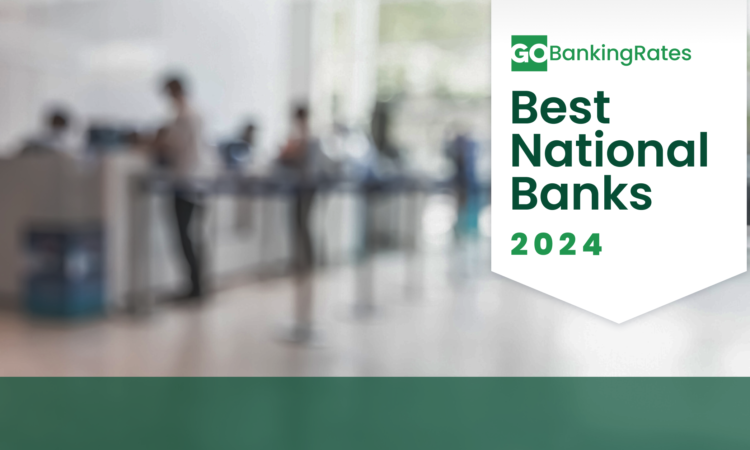
Research Methodology
To discover the Best National Banks, GOBankingRates looked at the top national institutions (located in 20 or more states). To determine rankings, GOBankingRates looked at the following factors: (1) total assets as sourced from the FDIC; (2) number of branch locations as sourced from the FDIC; (3) checking account annual fee; (4) savings account APY rate; (5) 12-month CD APY rate; (6) customer service products offered (24/7 customer service and live chat with a human); (7) Bauer rating (out of 5 stars); (8) products/services offered (auto loans, mortgage loans, credit cards, investment services and insurance); and (9) the average mobile app rating between the Android and Apple stores. All factors were then scored and combined, with the lowest score being best. Factors (1) and (4) were weighted 1.5 times, factors (2) and (8) were weighted 2 times, and factor (6) was weighted 0.5 times. For all savings and checking account data, only the basic accounts/products offered at each institution were analyzed. All data is up to date as of May 9, 2024.
What a National Bank Means
The purpose of a national bank, among other aspects, includes paying government bills and issuing a common currency people may transact with. National banks also assist businesses with transactions like lending money and cash deposits.
Differences Between National and Regional Banks
One of the primary differences between national banks and regional banks is size. National banks have many physical locations and a large ATM network while a regional bank is smaller physically as well in the amount of assets it has available.
Other differences include but are not limited to fee costs and customer service, the latter of which may be more personalized compared to a national bank’s more standardized services.
Pros and Cons of National Banks
Let’s review a few pros and cons associated with national banks.
Pros
- Single currency for the entire nation
- Sizeable amount of physical branches and ATM network
- Wide range of financial products and services
- Ability to manage federal government’s funds
Cons
- Fees may potentially be more expensive than at a smaller bank
- Customer service may be more standardized
- If the bank experiences a bank failure, its entire system of banks goes down
How To Choose a National Bank
Are you ready to become a banking customer at a national bank? Consider the following factors when choosing the right national bank for your financial needs.
Review the Fees
Fees are important when choosing a national bank since there are many common fees charged by banks which can quickly become expensive. Customers with larger deposits may be offered lower fees by national banks. If you find this pertains to your financial situation, find out if you qualify for lower fees and/or higher interest rates.
Read the Fine Print
Make sure to carefully read the fee schedule and account disclosures for the bank accounts you’re interested in as well as any other additional fine print outlining the terms and conditions of your account. Doing so will allow you to compare these offerings to other national banks and find any additional fees or restrictions you might not expect.
Check the APY
Many customers prioritize banking with financial institutions that have a high annual percentage yield. Most national banks are not known for high APY offerings on checking and savings accounts. This might be one reason why a recent GOBankingRates survey uncovered that 60% of participants keep $500 or less in checking, while 49% keep $500 or less in savings. However, it’s still worth reviewing a national bank’s website to learn more about its APY rates.
Explore the National Bank’s Website and App
Even if you plan to primarily bank in-person, it’s still a good idea to have an understanding of how to navigate and use the bank’s website and app. GOBankingRates found than over one in four, which is about 27% of survey respondents, do all of their banking online. This is about 31% of 25- to 34-year-olds. That shows an increasing reliance on this medium. Should something unforeseen happen and you need to conduct a bit of banking online, you’ll be glad you took the time to familiarize yourself with the bank’s website and app.
FDIC Insurance
The FDIC insures most deposits at national banks. These banks carry a standard insurance limit of $250,000 per depositor, per bank and per ownership category. Additionally, this standard insurance may also be supplemented with additional private insurance from national banks. It’s a good idea to review bank policies if you are considering a few national banks if you will require a great deal of supplemental account insurance from your financial institution.
Which National Banks Are Biggest?
In making this consideration, it’s a good idea to consider banks in terms of assets. A large financial institution includes firms with assets of $100 billion or more.
Caitlyn Moorhead, Daria Uhlig, Ann Logue, John Csiszar and Gabrielle Olya contributed to the reporting for this article.





